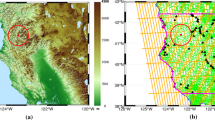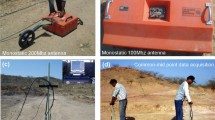Abstract
In April 2013, Rio Tinto Kennecott Copper’s (RTKC) Bingham Canyon Mine experienced what is arguably the world’s largest ever in-pit slope failure. The failure initiated on the east wall of the mine, along major, continuous, low-strength bedding faults, which were the upper and lower contact of the Manefay hornfels bed. The failure comprised approximately 145 million tonnes of rock and waste dump material. East wall slope deformations were detected some months prior to the catastrophic slope collapse by RTKC’s ground-based slope monitoring systems. Use of existing terrestrial radar and prism monitoring systems provided excellent data to manage the response to the slope collapse. The failure resulted in no injuries/loss of life, although the failure runout distance was longer than expected, resulting in the loss of mining equipment and significant production interruption. Post-failure investigations identified an RTKC-sponsored, university research project, which detected a zone of sporadic ground deformation at the crest of the Manefay failure using satellite-based Interferometric Synthetic Aperture Radar (InSAR) monitoring. When the outcomes of this research study were received in 2010, RTKC responded by conducting detailed field inspections, installing prisms in the area of concern and monitoring the area closely in the years before the event. Interferometric methods for calculating ground displacement from satellite-based synthetic aperture radar (SAR) data have improved significantly since the time leading up to the Manefay failure. These updated methods have been used in this study of the available historic SAR data with results indicating that significant ground movements were occurring over a number of years prior to failure. Detailed knowledge of these movements could potentially have led to a different interpretation of failure mechanisms and magnitude and, in hindsight, different slope management and mine development plans in the years preceding slope failure. From a business and mine operations perspective, the ability to identify subtle signs of slope failure before a catastrophic slope collapse is essential for appropriate management of such events. The use of InSAR monitoring, as discussed in this paper, provides an increased capability for further improved slope management at RTKC, and at other mining operations.



(adapted from Gibbs, 2018 unpublished)


















Similar content being viewed by others
References
Agliardi F, Riva F, Barbarano M, Zanchetta S, Scotti R, Zanchi A (2019) Effects of tectonic structures and long-term seismicity on paraglacial giant slope deformations: Piz Dora (Switzerland). Eng Geol 263:105353
Badger TC (2002) Fracturing within anticlines and its kinematic control on slope stability. Environ Eng Geosci 8(1):19–33
Barla G, Tamburini A, Del Conte S, Giannico C (2016) InSAR monitoring of tunnel induced ground movements. Geomechanik Und Tunnelbau 9(1):15–22
Benko B, Stead D (1998) The frank slide: a reexamination of the failure mechanism. Can Geotech J 35(2):299–311
Carlà T, Farina P, Intrieri E, Ketizmen H, Casagli N (2018) Integration of ground-based radar and satellite InSAR data for the analysis of an unexpected slope failure in an open-pit mine. Eng Geol 235:39–52
Carlà T, Intrieri E, Raspini F, Bardi F, Farina P, Ferretti A, Colombo D, Novali F, Casagli N (2019) Perspectives on the prediction of catastrophic slope failures from satellite InSAR. Sci Rep 9(1):14137–14139
Colombo D, MacDonald B (2015) Using advanced InSAR techniques as a remote tool. The Southern African Institute of Mining and Metallurgy, Slope Stability Conference 2015
Eberhardt E, Stead D, Styles T, Kyusek W (2010) Integration of InSAR with advanced numerical modeling methodology & results. Mine Subsidence Monitoring (MSM) EOADP Project, Report delivered exclusively to RTKC, Report # MSM-UBCSFU-10–004
Eriksen HØ, Lauknes TR, Larsen Y, Corner GD, Bergh SG, Dehls J, Pascal KH (2017) Visualizing and interpreting surface displacement patterns on unstable slopes using multi-geometry satellite SAR interferometry (2D InSAR). Remote Sens Environ 191:297–312
Gibbs J (2018). Bingham Canyon Geology Map. Rio Tinto Internal Report
Hatzor YH, Levin M (1997) The shear strength of clay-filled bedding planes in limestones—back-analysis of a slope failure in a phosphate mine. Israel Geotech Geol Eng 15(4):263–282
Henderson IHC, Lauknes TR, Osmundsen PT, Dehls J, Larsen Y (2011) Redfield TF (2011) A structural, geomorphological and InSAR study of an active rock slope failure development. Geol Soc Spec Pub 351(1):185–199
Hendron AJ, Patton FD (1985) The Vaiont slide, a geotechnical analysis based on new geologic observations of the failure surface. US Army Corps of Engineers Technical Report GL-85–5 (2 volumes).
Jung J, Gaida M, Sutherlin C, Ross B (2014) Utah SME Manefay Presentation. In: Society for Mining, Metallurgy, and Exploration 2014 Conference Presentation
Kemeny J (2003) The time-dependent reduction of sliding cohesion due to rock bridges along discontinuities: a fracture mechanics approach. Rock Mech Rock Eng 36(1):27–38
Kilburn CRJ, Petley DN (2003) Forecasting giant, catastrophic slope collapse: lessons from Vajont. Northern Italy Geomorphol 54(1):21–32
Leighton JM, Sullivan M (2020) InSAR in the clouds: satellite-based monitoring at Grasberg Mine. In: Proceedings of the 2020 International Symposium on Slope Stability in Open Pit Mining and Civil Engineering, Australian Centre for Geomechanics, Perth, pp. 281–292, https://doi.org/10.36487/ACG_repo/2025_14
López-Vinielles J, Ezquerro P, Fernández-Merodo JA, Béjar-Pizarro M, Monserrat O, Barra A, Blanco P, García-Robles J, Filatov A, García-Davalillo JC, Sarro R, Mulas J, Mateos RM, Azañón JM, Galve JP (2020) Herrera G (2020) Remote analysis of an open-pit slope failure: Las Cruces case study. Spain Landslides 17(9):2173–2188
Moffitt K, Cambio D, Carvalho J, Gaida M, Jung J, Yetisir M, Sherizadeh T (2018). Back-Analysis of the Bingham Canyon South Wall: A Quasi-Static Complex Movement Mechanism. ARMA 18–1366
Pankow KL, Moore JR, Hale M, Koper KD, Whidden KM, McCarter MK (2013) Massive landslide at Utah copper mine generates wealth of geophysical data. GSA Today 24(1):4–9
Porter J, Schroeder K, Austin G (2012) Geology of Bingham canyon porphyry Cu–Mo–Au deposit. Soc Econ Geol Special Publ 16:127–146
Presnell RD (1998) Structural controls on the plutonism and metallogeny in the wasatch and oquirrh mountains. Soc Econ Geol Guidebook Series Volume, Utah, p 29
Robertson J (2015) Deep-seated bedrock landsliding in Grand Canyon's Surprise Valley area. Thesis https://digitalrepository.unm.edu/eps_etds/72
Ross B (2015) Rise to the Occasion. Society for Mining, Metallurgy & Exploration
Schaefer LN, Di Traglia F, Chaussard E, Lu Z, Nolesini T, Casagli N (2019) Monitoring volcano slope instability with synthetic aperture radar: a review and new data from Pacaya (Guatemala) and Stromboli (Italy) Volcanoes. Earth Sci Rev 192:236–257
Severin J, Eberhardt E,Fortin S (2013) Open pit numerical model calibration using a pseudo three-dimensional radar monitoring technique. In: Proceedings of the 2013 international symposium on slope stability in open pit mining and civil engineering, australian centre for geomechanics, Perth, pp. 639–652, https://doi.org/10.36487/ACG_rep/1308_42_Severin
Sreejith KM, Sunil PS, Agrawal R, Saji, AP, Ramesh DS, Rajawat AS (2016) Coseismic and Early Postseismic Deformation Due to the 25 April 2015, M W 7.8 Gorkha, Nepal, Earthquake from InSAR and GPS Measurements. Geophys Res Lett 43(7): 3160–168.
Stead D, Wolter A (2015) A critical review of rock slope failure mechanisms: the importance of structural geology. J Struct Geol 74:1–23
Styles T, Rabus B, Bloom J (2011) Integrated Numerical Modelling and Insar Monitoring of a Slow Moving Slope Instability at Bingham Canyon Mine. In: Slope Stability 2011, international symposium on rock slope stability in open pit mining and civil engineering, Vancouver, Canada.
Vergara MR, Van Sint JM, Lorig L (2016) Numerical model for the study of the strength and failure modes of rock containing non-persistent joints. Rock Mech Rock Eng 49(4):1211–1226
Zavodni Z (2001) Time-dependent movement of open-pit slopes. In: Slope stability in surface mining. Society for mining, metallurgy, and exploration, Chapter 8: 81–87
Zhou C, Gong H, Chen B, Li J, Gao M, Zhu F, Chen W, Liang Y (2017) InSAR time-series analysis of land subsidence under different land use types in the Eastern Beijing Plain, China. Remote Sens (basel, Switzerland) 9(4):380
Acknowledgements
The authors would like to thank Rio Tinto, and the technical staff of the Bingham Canyon Mine, for allowing this information to be published and shared for the benefit of the rock mechanics and geotechnical engineering community. Authors would also like to thank 3vGeomatics for donating countless hours of research time into this important project.
Author information
Authors and Affiliations
Corresponding author
Ethics declarations
Conflict of interest
The authors declare that they have no conflict of interest.
Additional information
Publisher's Note
Springer Nature remains neutral with regard to jurisdictional claims in published maps and institutional affiliations.
Rights and permissions
About this article
Cite this article
Williams, C., Ross, B., Zebker, M. et al. Assessment of the Available Historic RADARSAT-2 Synthetic Aperture Radar Data Prior to the Manefay Slide at the Bingham Canyon Mine Using Modern InSAR Techniques. Rock Mech Rock Eng 54, 3469–3489 (2021). https://doi.org/10.1007/s00603-021-02483-2
Received:
Accepted:
Published:
Issue Date:
DOI: https://doi.org/10.1007/s00603-021-02483-2




